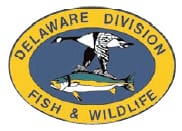Delaware DNREC’s Annual Mid-Winter Survey Finds Record Number Of Bald Eagles


DOVER, Del – –(AmmoLand.com)- In past years, the Delaware Division of Fish and Wildlife’s annual Mid-Winter Bald Eagle Survey – conducted as part of a nationwide survey – has found fewer than 40 birds in the state.
However, in the just-completed 2010 survey, DNREC Wildlife Biologist Anthony Gonzon tallied a record 120 bald eagles – 77 adults and 43 immature birds, including resident nesting birds as well as winter visitors. The survey also located two new eagle nests, increasing the number of eagle territories in Delaware to 60.
“The Division had been receiving recent reports from the public of up to 40 eagles in one place at one time, and the numbers we observed during the mid-winter flight further support that Delaware can be a great place for bald eagles during the winter,” said Gonzon. He also noted that the actual number of bald eagles currently in Delaware could be higher, as more eagles are likely overwintering in parts of western Sussex County and north of the C&D Canal in New Castle County, both areas not covered by the survey.
Federally de-listed as an endangered species by the United States Fish and Wildlife Service in 2007, bald eagles remain listed as endangered in Delaware. Although they are not as rare as in the last century, bald eagles continue to face many threats such as disturbance, pollutants and habitat loss. Coordinated through the United States Geological Survey and the United States Army Corps of Engineers, the mid-winter survey produces data that allows state and federal agencies to examine population trends in our national bird.
During the winter, Delaware is second home for some bald eagles whose breeding grounds are farther north. These visitors come south to take advantage of food resources ranging from fish to carrion that may not be as plentiful in their northern territories in the winter. Because many birds will feed on road-killed animals and may not perceive the threat of an oncoming vehicle, winter can be a dangerous time.
“In October 2009, a bald eagle was struck and killed by car while feeding along a roadside near Seaford, so motorists need to be especially aware of their possible presence on the roadways,” Gonzon said.
In January, Delaware’s resident bald eagles are conducting nest maintenance, preparing to nest and defending their nesting territories from the northern invaders and each other. Once numbering as few as two to four nesting pairs during the 1980s, bald eagles continue to rebound in Delaware, largely due to federal protections.
Delaware’s mid-winter survey also marks the beginning of the Division’s annual nest monitoring program. From January through May, the Division conducts monthly aerial surveys of all known bald eagle nest sites. In 2009, the Division monitored 56 active bald eagle nesting territories in Delaware.
“In these territories, 48 eagle pairs attempted nesting and successfully raised 60 young. That was nine fewer than 2008 when Delaware’s eagles produced an astounding 69 young,” Gonzon noted. “During the mid-winter survey, we observed a number of our birds that are already close to laying the first eggs of 2010,” he added.
With the high number of wintering and resident bald eagles, Delawareans could potentially see a bald eagle perched in a tree or soaring high overhead in many locations throughout the state. As part of the annual monitoring program, the Division encourages citizens to report such sightings to help track our resident bald eagles and locate possible new nest sites.
Here are some tips for reporting bald eagle sightings:
- Note the number of eagles observed and whether each eagle is an adult or immature.
- Adults display the distinctive completely white heads and tails. Immature bald eagles have mostly brown heads and tails, often with some white on their breasts and bellies, as well as under the wings.
- Note what the eagle is doing. Is it flying or sitting? Is it carrying something or eating on the ground?
- If the bald eagle is flying, please note the direction that it flew from and the direction in which it was headed.
- Note the time, date and location of the observation. Use nearest towns and intersections or prominent landmarks as reference points (for example, on Route 6, a half mile west of the intersection with Route 9).
- If you believe you have located a bald eagle nest, please contact the Division as soon as possible. Please do not approach nesting eagles, as some pairs may be highly disturbed by innocent spectators.
The Division of Fish and Wildlife also receives many calls about possibly injured eagles, often sitting in fields or yards for long periods of time. In most cases, the eagles are perfectly healthy. Bald eagles may remain in a single location for hours as they recover from a territorial battle with other adult eagles or as they feed, rest and conserve energy.
“These are large, strong birds that are capable of injuring a would-be rescuer, so we encourage the public not to approach or attempt to capture any potentially injured eagle. Instead, observe the bird from a distance and note whether it appears to be in distress or having difficulty flying, before contacting someone with the proper training to help,” Gonzon said.
To report observations, potential nests or possible injuries, or to ask other questions, please contact Wildlife Biologist Anthony Gonzon, Division of Fish and Wildlife, Natural Heritage and Endangered Species Program, at 302-653-2880, or by email at anthony.gonzon@state.de.us.
